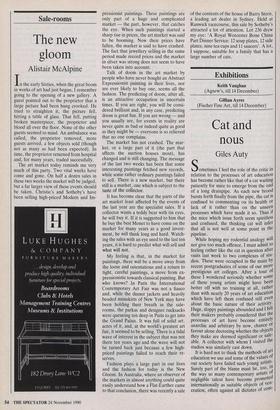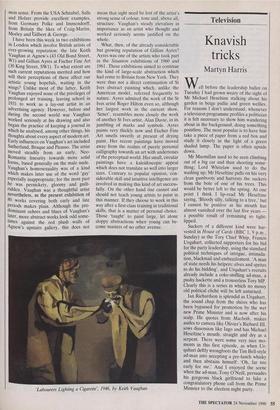Exhibitions
Keith Vaughan (Agnew's, till 14 December) Gillian Ayres (Fischer Fine Art, till 14 December)
Cat and nous
Giles Auty
Sometimes I feel the role of the critic in relation to the processes of art education has become rather like that of a cat waiting patiently for mice to emerge from the end of a long drainpipe. As each new brood bursts forth finally from the pipe, the cat is confined to commenting on its health or lack of it rather than on the unseen processes which have made it so. Thus if the mice which issue forth seem spiritless and confused, the thinking cat will infer that all is not well at some point in the pipeline. While hoping my rodential analogy Will not give too much offence, I must admit to feeling rather like the cat in question after visits last week to two complexes of stu- dios. These were occupied in the main by recent postgraduates of some of our more prestigious art colleges. After a tour of these I wondered seriously whether some of these young artists might have been better off with no training at all, rather than with nearly 20 years of art education which have left them confused still even about the basic nature of their activity. Huge, sloppy paintings abounded and I felt their makers probably considered that the processes of art have become entirely anarchic and arbitrary by now, chance or favour alone decreeing whether the objects they make are deemed significant or sale- able. A collector with whom I visited the studios was similarly cast down. It is hard not to think the methods of art education we use and some of the values of our society have failed such young
artists.
Surely part of the blame must lie, too, in the way so many contemporary artists of negligible talent have become promoted internationally as suitable objects of ven- eration, often against all dictates of corn-
mon sense. From the USA Schnabel, Salle and Holzer provide excellent examples, from Germany PoIke and Immendorff, from Britain the likes of Craig-Martin, Morley and bilbert & George.
I have been this week to two exhibitions in London which involve British artists of ever-growing reputation: the late Keith Vaughan at Agnew's (43 Old Bond Street, W1) and Gillian Ayres at Fischer Fine Art (30 King Street, SW1). To what extent are such current reputations merited and how will their perceptions of these affect our artistic young hopefuls, waiting in the wings? Unlike most of the latter, Keith Vaughan enjoyed none of the privileges of Prolonged art training, leaving school in 1931 to work as a lay-out artist in an advertising agency. However, before and during the second world war Vaughan worked seriously at his drawing and also began the practice of keeping a journal in Which he analysed, among other things, his thoughts about every aspect of modern art. Early influences on Vaughan's art included Sutherland, Braque and Picasso. The artist moved steadily from an early, Neo- Romantic linearity towards more solid forms, based generally on the male nude. Vaughan's homosexuality was of a kind Which makes later use of the word 'gay' especially inappropriate; for the most part -he was pernickety, gloomy and guilt- ridden. Vaughan was a thoughtful artist nevertheless, as the present exhibition of 80 works covering both early and late periods makes plain. Although the pre- dominant ochres and blues of Vaughan's later, more abstract works look odd some- times against the red plush walls of Agnew's upstairs gallery, this does not
mean that sight need be lost of the artist's strong sense of colour, tone and, above all, structure. Vaughan's steady elevation in importance as an artist who thought and worked seriously seems justified on the whole.
What, then, of the already considerable but growing reputation of Gillian Ayres? Ayres was one of the artists who took part in the Situation exhibitions of 1960 and 1961. These exhibitions aimed to continue the kind of large-scale abstraction which had come to Britain from New York. They were thus not a direct continuation of St Ives abstract painting which, unlike the American model, referred frequently to nature. Ayres admired the work of the St Ives artist Roger Hilton even so, although her largest work in the current show, `Senee, resembles more closely the work of another St Ives artist, Alan Davie, in its jumbling of marks and symbols. Ayres paints very thickly now and Fischer Fine Art smells sweetly at present of drying paint. Her recent paintings have moved away from the realms of purely personal calligraphy towards an art with undertones of the perceptual world. Her small, circular paintings have a kaleidoscopic appeal which does not translate so well into larger sizes. Contrary to popular opinion, con- siderable skill and intuitive intelligence are involved in making this kind of art success- fully. On the other hand one cannot and should not teach young artists to paint in this manner. If they choose to work in this way after a first-class training in traditional skills, that is a matter of personal choice. Those 'taught' to paint large, let alone sloppy abstractions when young can be- come masters of no other avenue.
'Labourers Lighting a Cigarette', 1946, by Keith Vaughan



































































 Previous page
Previous page